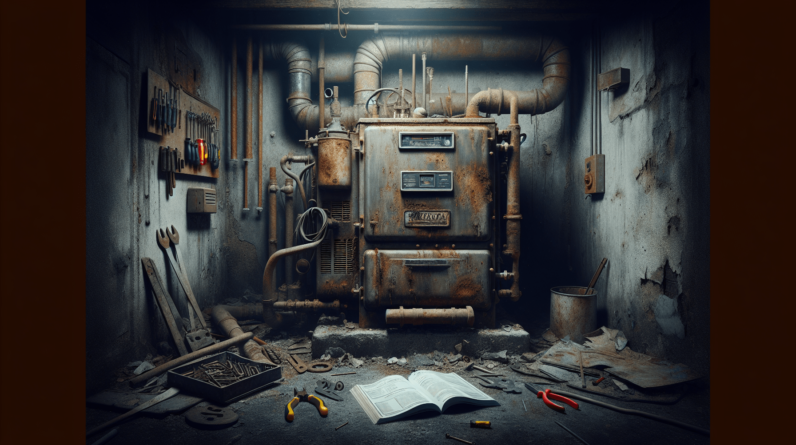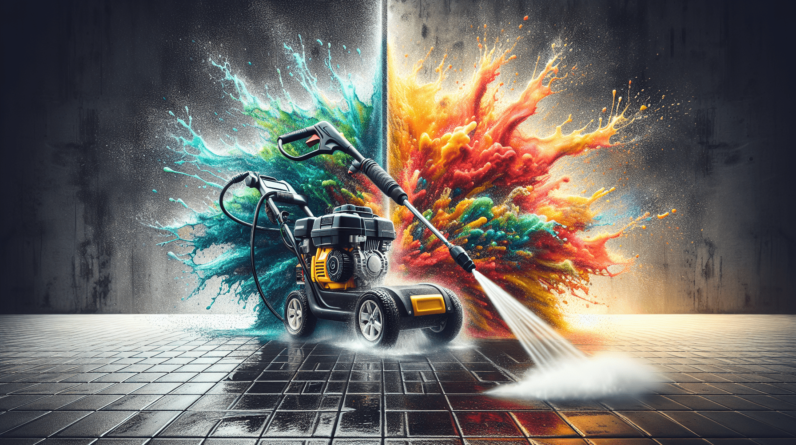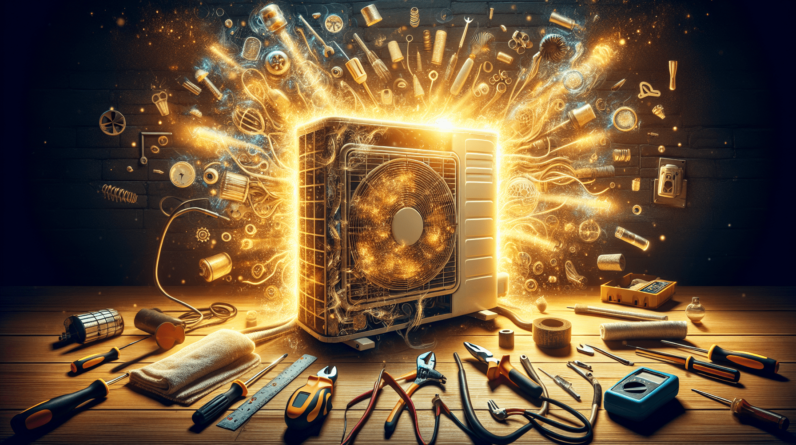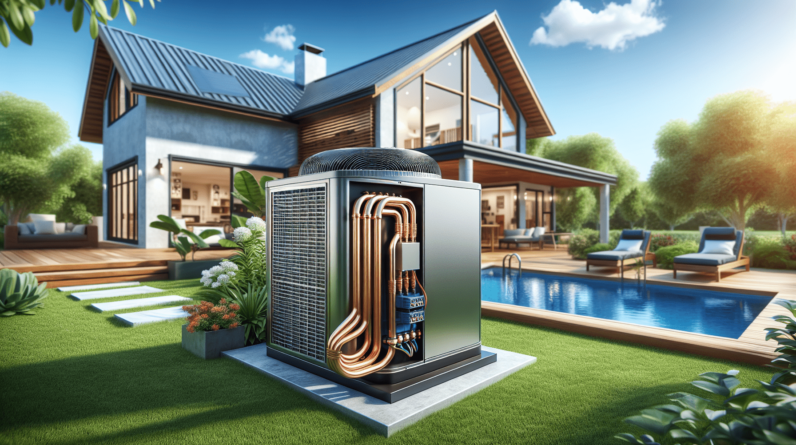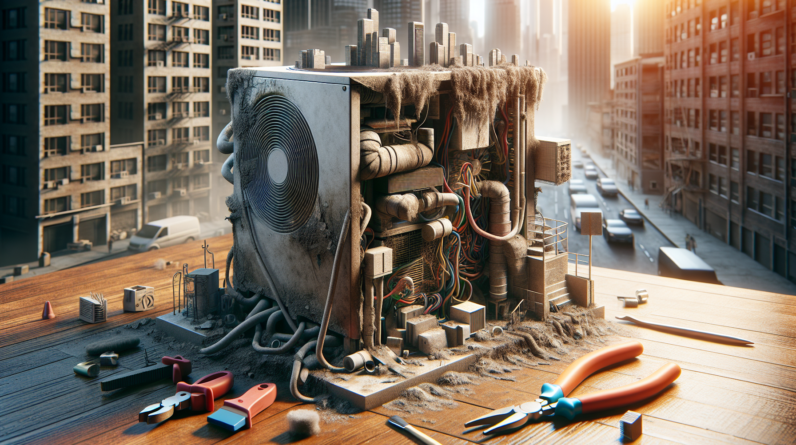

Imagine this: you’re sitting comfortably in your living room, enjoying the pleasant temperature provided by your HVAC system. Everything seems perfect until, suddenly, the system stops working. Panic sets in as you start to wonder what could possibly be the cause of this inconvenience. Is it a faulty thermostat? Or maybe a malfunctioning compressor? In this article, we will explore the number one problem that plagues HVAC systems, shedding light on the often overlooked culprit behind your HVAC troubles. Get ready to uncover the mystery and find out what’s really going on with your HVAC system.
Different Types of HVAC Systems
Split systems
Split systems are one of the most common types of HVAC systems used in residential and commercial buildings. These systems consist of two main components: an outdoor unit, which houses the compressor and condenser, and an indoor unit, which contains the evaporator coil. The outdoor and indoor units are connected by refrigerant lines, allowing for the transfer of heat and cooling between the two units. Split systems are known for their efficiency and reliability, making them a popular choice among homeowners.
Ductless systems
Ductless systems, also known as mini-split systems, are designed to provide heating and cooling without the need for air ducts. These systems consist of an outdoor unit and one or more indoor units, which are mounted on the wall or ceiling of individual rooms. Each indoor unit is connected to the outdoor unit by a refrigerant line, allowing for independent temperature control in each room. Ductless systems offer flexibility in terms of zoning and can be a great option for homes without existing ductwork.
Packaged heating and cooling systems
Packaged heating and cooling systems are typically used in commercial buildings or homes with limited space. These systems include all the necessary components, such as the compressor, condenser, and evaporator, in a single outdoor unit that is usually installed on the roof or a concrete pad. The conditioned air is distributed through ductwork and vents, providing consistent heating and cooling throughout the building. Packaged systems are known for their efficiency and ease of installation, making them a popular choice for commercial applications.
Heat pumps
Heat pumps are a type of HVAC system that can provide both heating and cooling. Unlike other systems that generate heat or cooling, heat pumps transfer heat from one place to another. In colder weather, heat pumps extract heat from the outdoor air or ground and transfer it inside to warm the space. In warmer weather, the process is reversed to remove heat from the indoor air and release it outside, cooling the space. Heat pumps are known for their energy efficiency and can be a cost-effective solution for both heating and cooling needs.
Regular Maintenance and Cleaning
Dirty filters
One common problem with HVAC systems is dirty filters. Over time, the air filters in the system can become clogged with dust, dirt, and other debris, impeding the airflow and reducing the system’s efficiency. This can lead to poor indoor air quality, increased energy consumption, and even damage to the HVAC system. Regularly cleaning or replacing the air filters is crucial for maintaining optimal performance and prolonging the lifespan of the system.
Clogged condensate drain lines
Another maintenance issue that can arise is clogged condensate drain lines. HVAC systems produce condensation as they cool the air, and this moisture needs to be drained away from the system. If the condensate drain lines become clogged with algae, dirt, or debris, it can cause water to back up and potentially damage the system. Regular cleaning and maintenance of the condensate drain lines are necessary to prevent this problem and ensure proper drainage.
Blocked vents and registers
Blocked vents and registers can restrict the airflow and disrupt the balance of the HVAC system. Furniture, curtains, or other objects placed in front of vents can obstruct the airflow, making it difficult for the system to effectively heat or cool the space. Regularly checking and clearing any obstructions from vents and registers is essential for maintaining proper airflow and temperature control throughout the building.
Dust accumulation on coils
The coils in the HVAC system, both the evaporator coil and the condenser coil, can accumulate dust and dirt over time. This can impair heat transfer and reduce the system’s efficiency. Regular inspection and cleaning of the coils are necessary to remove any dust or debris that may have accumulated. This can help improve the efficiency of the system, reduce energy consumption, and extend the life of the equipment.
Refrigerant Leaks
Signs of refrigerant leaks
Refrigerant leaks can occur in HVAC systems and can result in a range of problems. Some common signs of refrigerant leaks include reduced cooling or heating performance, longer cooling or heating cycles, hissing or bubbling sounds near the indoor or outdoor unit, or an increase in energy bills. If you suspect a refrigerant leak, it is important to have it addressed promptly to prevent further damage to the system.
Causes of refrigerant leaks
Refrigerant leaks can be caused by a variety of factors, including aging equipment, poor installation, manufacturing defects, or physical damage to the system. Over time, wear and tear on the system can cause leaks to develop, leading to a loss of refrigerant and decreased performance. It is important to have regular maintenance inspections to identify and address any potential refrigerant leaks before they escalate into larger issues.
Effects of refrigerant leaks
Refrigerant leaks can have several negative effects on HVAC systems. A decrease in refrigerant levels can lead to a decrease in cooling or heating capacity, resulting in a less comfortable indoor environment. Leaks can also cause the system to work harder, leading to increased energy consumption and higher utility bills. Additionally, refrigerant leaks can put strain on the compressor and other components, potentially causing them to fail prematurely. Prompt detection and repair of refrigerant leaks are essential to maintain the system’s efficiency and prevent further damage.
Refrigerant leak detection and repair
To detect and repair refrigerant leaks, it is best to contact a qualified HVAC technician. They have the knowledge and tools to locate and fix leaks efficiently and effectively. The technician will perform a thorough inspection of the system, checking for any signs of leaks. If a leak is detected, they will repair it using industry-standard practices and ensure that the system is properly recharged with refrigerant. Regular maintenance and inspections can help prevent refrigerant leaks and ensure the smooth operation of the HVAC system.

Inadequate Airflow
Causes of inadequate airflow
Inadequate airflow can be caused by a variety of factors. One common cause is dirty or clogged air filters. When air filters become dirty, they can restrict the airflow, making it difficult for the system to distribute conditioned air throughout the space effectively. Another cause of inadequate airflow can be blocked or closed vents and registers. Objects or furniture placed in front of vents can obstruct the airflow, preventing proper ventilation. Additionally, undersized or blocked air ducts can restrict the airflow and reduce the system’s efficiency.
Effects of inadequate airflow
Inadequate airflow can lead to several problems within an HVAC system. Reduced airflow can result in uneven heating or cooling, with some areas of the building being warmer or cooler than others. This can create discomfort for occupants and may require the system to work harder to compensate for the imbalance. Inadequate airflow can also cause the system to operate inefficiently, resulting in increased energy consumption and higher utility bills. It is important to address and rectify any airflow issues to ensure optimal performance and comfort.
Measuring and improving airflow
Measuring and improving airflow is a key step in maintaining an efficient HVAC system. One way to measure airflow is by using an anemometer, a device specifically designed to measure air velocity. By measuring the airflow at different points in the system, technicians can identify any areas of low airflow and determine the best course of action to improve it. Improvements can include cleaning or replacing air filters, removing obstructions from vents and registers, and ensuring that air ducts are properly sized and unobstructed.
Air duct inspection and cleaning
Air ducts play a crucial role in the airflow of an HVAC system. Over time, air ducts can accumulate dust, dirt, and other debris, which can restrict the airflow and reduce the system’s efficiency. Regular inspection and cleaning of the air ducts are essential to prevent any blockages and maintain proper airflow. Professional HVAC technicians can perform thorough inspections, identify any issues, and clean the air ducts using industry-standard practices. This helps improve the overall performance of the system and ensures that conditioned air is distributed efficiently throughout the building.
Thermostat Issues
Malfunctioning thermostat
Thermostat issues can disrupt the normal operation of an HVAC system. A malfunctioning thermostat can result in inaccurate temperature readings, failure to turn on or off, or erratic temperature control. If you notice any irregularities with your thermostat, it is important to have it inspected and repaired or replaced if necessary. A qualified HVAC technician can diagnose the problem and ensure that your thermostat is functioning properly.
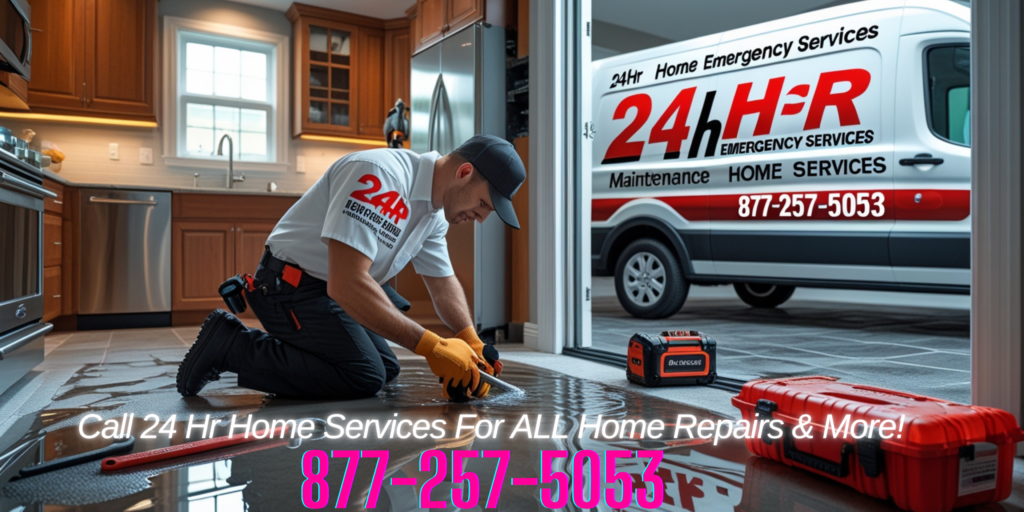
Incorrect thermostat settings
Incorrect thermostat settings can also contribute to HVAC issues. If the thermostat is set too high or too low, it may not provide the desired heating or cooling in the space. Additionally, if the thermostat is set to the wrong mode, such as cooling instead of heating or vice versa, it can lead to discomfort and inefficiency. It is important to ensure that your thermostat is set correctly for optimal temperature control and energy efficiency.
Inaccurate temperature readings
Inaccurate temperature readings from the thermostat can cause problems, as the system may not respond accurately to the actual temperature in the space. This can result in underheating or overcooling, leading to discomfort for occupants. Regular calibration and maintenance of the thermostat are necessary to ensure accurate readings and proper temperature control. If you suspect that your thermostat is providing inaccurate readings, it is best to consult a professional technician to address the issue.
Upgrade to a programmable thermostat
Upgrading to a programmable thermostat can offer several benefits for your HVAC system. Programmable thermostats allow you to set different temperature schedules for different times of the day and days of the week. This can help optimize energy usage, as you can adjust the temperature settings to match your daily routine and reduce heating or cooling when the space is unoccupied. Programmable thermostats also offer convenient features such as remote control and energy monitoring, providing you with greater control over your HVAC system and potential cost savings.
Electrical Problems
Faulty electrical connections
Electrical problems can pose significant issues for HVAC systems. One common issue is faulty electrical connections, which can disrupt the flow of electricity to various components of the system. Loose or damaged electrical connections can cause the system to malfunction or fail to operate altogether. It is important to have a qualified HVAC technician inspect and repair any electrical connections that may be faulty to ensure the safe and reliable operation of the system.
Worn-out capacitors
Capacitors are electrical devices that store and release electrical energy to help start and run the motors in an HVAC system. Over time, capacitors can become worn out or fail, resulting in various issues with the system. Symptoms of worn-out capacitors can include difficulty starting the system, motor hesitation or stalling, or unusual sounds coming from the system. If you suspect a capacitor issue, it is important to have it addressed promptly to prevent further damage to the system.
Problems with fan motor
The fan motor in an HVAC system plays a crucial role in circulating air throughout the space. Problems with the fan motor can result in inadequate airflow, reduced cooling or heating performance, or complete system failure. Faulty bearings, motor overheating, or worn-out belts are a few common issues that can affect the fan motor. Regular maintenance and inspections can help identify and address any problems with the fan motor before they escalate into major issues.
Burnt-out wiring
Burnt-out wiring is another electrical problem that can impact the operation of an HVAC system. Over time, wiring can degrade or become damaged due to various factors such as heat, age, or improper installation. Burnt-out wiring can cause the system to short-circuit, leading to power failures or even electrical fires. If you notice any burning smells, flickering lights, or other signs of electrical issues, it is important to have a professional technician inspect and repair the wiring to ensure the safe operation of the system.
Uneven Temperatures
Causes of uneven temperatures
Uneven temperatures within a building can be a frustrating problem. There can be several causes behind this issue, such as poor insulation, improper HVAC system sizing, or ductwork issues. Inadequate insulation can allow heat or cool air to escape, resulting in temperature imbalances. Similarly, an HVAC system that is too small or too large for the space may struggle to evenly distribute conditioned air. Additionally, problems with the air ducts, such as leaks or blockages, can disrupt the airflow and contribute to uneven temperatures.
Improving temperature balance
Improving temperature balance in a building requires addressing the underlying causes of the temperature imbalances. Upgrading or adding insulation can help minimize heat transfer and maintain a more consistent temperature throughout the space. Ensuring that the HVAC system is properly sized for the building’s needs is also important. If the air ducts are causing temperature imbalances, professional inspection and repair can help improve airflow and promote more even temperatures.
Zoning systems
Zoning systems can be an effective solution for addressing temperature imbalances in a building. Zoning systems divide the building into different zones, each with its own thermostat and independent temperature control. This allows for customized heating and cooling in different areas of the building based on specific needs and preferences. Zoning systems can help overcome temperature variations and provide greater comfort and energy efficiency.
Upgrading insulation
Upgrading insulation in a building can have a significant impact on temperature balance. Proper insulation helps reduce heat transfer through walls, floors, and ceilings, ensuring that the conditioned air stays inside and external heat or cold stays out. Adding or improving insulation in key areas can help maintain a more consistent temperature throughout the building, reducing the need for excessive heating or cooling and improving energy efficiency. Consultation with an insulation specialist can help determine the best insulation options for your specific building.
Noisy Operation
Causes of HVAC system noise
Noisy operation is a common problem with HVAC systems that can be caused by several factors. Loose or worn-out parts, such as fan blades, belts, or bearings, can create rattling or squealing noises. Excessive vibration can also cause noise, indicating a problem with the motor or other components. Additionally, air ducts that are improperly sized or not properly insulated can lead to noisy operation, as air rushes through the system. Identifying the source of the noise is crucial in order to address and resolve the issue.
Common noises and their solutions
Different types of noises in an HVAC system can indicate specific problems. Rattling noises can suggest loose parts that need to be tightened or replaced. Squealing or screeching noises can be a sign of worn-out belts or bearings that require immediate attention. Vibration noises can be caused by imbalanced or loose components, which should be inspected and corrected. Noisy air ducts can be silenced by resizing, insulating, or sealing them to minimize air turbulence. Professional HVAC technicians can accurately diagnose the source of the noise and provide the necessary solutions.
Importance of professional inspection
When it comes to noisy HVAC systems, it is important to seek professional inspection and repair. Attempting to diagnose and fix the issue yourself can be risky and may lead to further damage or safety hazards. Professional technicians have the expertise and tools to identify the root cause of the noise and ensure that it is addressed correctly. Regular professional inspections can also help prevent potential noise issues from arising by identifying and resolving problems before they escalate.
Frequent Cycling On and Off
Thermostat issues
Frequent cycling on and off, also known as short cycling, can be caused by thermostat issues. A malfunctioning thermostat can send incorrect signals to the system, causing it to turn on and off more frequently than necessary. This can lead to increased wear and tear on the system, decreased energy efficiency, and discomfort for occupants. If you notice that your HVAC system is cycling on and off more frequently than usual, it is important to have the thermostat inspected and repaired or replaced, if needed.
Dirty filters or coils
Dirty filters or coils can contribute to frequent cycling on and off. When air filters or coils become blocked with dust and debris, it restricts the airflow and can cause the system to overheat. In response, the system may cycle on and off to try to regulate the temperature. Regularly cleaning or replacing air filters and coils is essential for maintaining proper airflow and preventing overheating, which can help reduce short cycling.
Improperly sized HVAC system
An HVAC system that is improperly sized for the building’s needs can also lead to frequent cycling on and off. If the system is too large, it may cool or heat the space too quickly, causing it to cycle on and off more frequently. Conversely, if the system is too small, it may struggle to reach the desired temperature and cycle on and off in an attempt to maintain it. Ensuring that the HVAC system is properly sized for the building’s requirements can help alleviate short cycling issues.
Improving cycling efficiency
To improve cycling efficiency and prevent frequent on and off cycles, it is important to address any underlying causes. Regular maintenance and inspections can help ensure that the system is clean and in good working condition. Properly sized air filters and clean coils can help maintain optimal airflow and prevent overheating. If short cycling issues persist, it is best to consult with a professional HVAC technician to identify any additional factors contributing to the problem and determine the best course of action.
Poor Indoor Air Quality
Sources of indoor air pollution
Poor indoor air quality is a concerning issue that can negatively impact the health and comfort of building occupants. There are several sources of indoor air pollution, including dust, pollen, pet dander, mold, volatile organic compounds (VOCs) from cleaning products or furnishings, and outdoor pollutants that infiltrate the building. Inadequate ventilation, improper filtration, and poor maintenance of HVAC systems can exacerbate indoor air quality problems. Identifying and addressing the sources of indoor air pollution is crucial in maintaining a healthy indoor environment.
Effects of poor indoor air quality
Poor indoor air quality can have significant effects on the health and well-being of occupants. Symptoms may range from mild irritations, such as headaches, fatigue, and respiratory issues, to more severe conditions like asthma or allergies. Prolonged exposure to indoor air pollutants can lead to chronic health problems and reduced productivity. Additionally, poor indoor air quality can cause unpleasant odors and diminish the overall comfort and enjoyment of the space. Implementing measures to improve indoor air quality is essential for creating a healthy and pleasant indoor environment.
Air purification solutions
Air purification solutions can effectively remove or reduce indoor air pollutants, improving the overall air quality. There are several types of air purification systems available, including mechanical filters, electrostatic precipitators, activated carbon filters, and UV germicidal lamps. Mechanical filters, such as HEPA filters, can capture small particles like dust, pollen, and pet dander. Electrostatic precipitators use an electrical charge to remove particles from the air. Activated carbon filters can help absorb odors and chemicals. UV germicidal lamps can kill bacteria, viruses, and mold. Choosing the appropriate air purification system depends on the specific indoor air quality concerns and needs.
Ventilation and filtration systems
Proper ventilation and filtration systems are crucial for maintaining good indoor air quality. Adequate ventilation helps remove stale air and provide fresh air from outside. Mechanical ventilation systems, such as exhaust fans or air exchangers, can help ensure consistent airflow and prevent the buildup of indoor air pollutants. Additionally, high-quality air filters in the HVAC system can capture and remove particles from the air, improving air quality. Regular maintenance and cleaning of ventilation and filtration systems, as well as timely filter replacements, are essential for optimal performance and clean indoor air.
In conclusion, HVAC systems can encounter various problems that can affect their performance, efficiency, and the comfort of building occupants. Regular maintenance, cleaning, and inspections are essential to identify and address these issues promptly. Whether it’s dirty filters, refrigerant leaks, inadequate airflow, thermostat problems, electrical issues, uneven temperatures, noisy operation, frequent cycling, or poor indoor air quality, taking the necessary steps to resolve these problems can help ensure the smooth and efficient operation of HVAC systems and create a comfortable, healthy indoor environment.

